Review on the Application of Artificial Intelligence in Smart Homes
Abstract
1. Introduction
2. Materials and Methods
2.1. Literature Review Method
2.2. Product Review Method
2.3. Analysis of the Application of AI in Smart Homes
3. Results and Discussion
3.1. Result of Literature Review
3.1.1. First-Round Selection of Literature
3.1.2. Second-Round Selection of Literature
3.2. Results of Product Review
3.3. Relationship between Literature and Products
4. Conclusions
Author Contributions
Funding
Conflicts of Interest
Appendix A
| Function | Technology | Title | Year | Discipline |
|---|---|---|---|---|
| Device Management | Data Processing | Design of TensorFlow-based proactive smart home managers | 2018 | Engineering |
| Device Management | Data Processing | Created in close interaction with the industry: the smart appliances reference (SAREF) ontology | 2015 | Computer Science |
| Device Management | Data Processing | A semantics-rich information technology architecture for smart buildings | 2014 | Engineering |
| Device Management | Decision-Making | Rudas: energy and sensor devices management system in home automation | 2016 | Other |
| Device Management | Image Recognition | Artificial intelligence shoe cabinet using deep learning for smart homes | 2019 | Engineering |
| Device Management | Prediction-Making; Decision-Making | Intelligent control in smart home based on adaptive neuro fuzzy inference system | 2016 | Other |
| Device Management | Voice Recognition; Decision-Making | A voice-controlled smart home solution with a centralized management framework implemented using AI and NLP | 2018 | Computer Science |
| Energy Management | Activity Recognition | User activity recognition for energy saving in smart home environment | 2016 | Computer Science |
| Energy Management | Activity Recognition | Unsupervised detection of unusual behaviors from smart home energy data | 2016 | Computer Science |
| Energy Management | Activity Recognition | A user behavior-driven smart-home gateway for energy management | 2016 | Computer Science |
| Energy Management | Data Processing | Electrical energy management based on a hybrid artificial neural network–particle swarm optimization-integrated two-stage non-intrusive load monitoring process in smart homes | 2018 | Engineering |
| Energy Management | Data Processing | PicoGrid smart home energy management system | 2018 | Computer Science |
| Energy Management | Data Processing | Improved thermal comfort modeling for smart buildings: a data analytics study | 2018 | Engineering |
| Energy Management | Data Processing | Smart personalized learning system for energy management in buildings | 2018 | Computer Science |
| Energy Management | Data Processing | Smart building: use of the artificial neural network approach for indoor temperature forecasting | 2018 | Engineering |
| Energy Management | Data Processing | Rule-based system to detect energy efficiency anomalies in smart buildings, a data mining approach | 2016 | Computer Science |
| Energy Management | Data Processing | Multi-agent system design for energy saving in intelligent building | 2016 | Computer Science |
| Energy Management | Data Processing | SESAME-S: semantic smart home system for energy efficiency | 2013 | Computer Science |
| Energy Management | Data Processing | Observe, learn, and adapt (OLA)—an algorithm for energy management in smart homes using wireless sensors and artificial intelligence | 2012 | Computer Science |
| Energy Management | Decision-Making | Fuzzy leaky bucket with application to coordinating smart appliances in smart homes | 2018 | Computer Science |
| Energy Management | Image Recognition | Low-cost appliance control system for home automation and energy management using image processing | 2016 | Computer Science |
| Energy Management | Prediction-Making | Local forecasting for predictive smart home/object control | 2018 | Other |
| Energy Management | Prediction-Making | IoT and machine learning-based prediction of smart building indoor temperature | 2018 | Computer Science |
| Energy Management | Prediction-Making | Indoor air-temperature forecast for energy-efficient management in smart buildings | 2018 | Engineering |
| Energy Management | Prediction-Making | Comparative study of artificial neural network models for forecasting the indoor temperature in smart buildings | 2017 | Computer Science |
| Energy Management | Prediction-Making | A hybrid adaptive rule-based system for smart home energy prediction | 2017 | Computer Science |
| Energy Management | Prediction-Making | Urban sensing and smart home energy optimizations: a machine learning approach | 2015 | Computer Science |
| Energy Management | Prediction-Making | Predicting smart home lighting behavior from sensors and user input using very fast decision tree with kernel density estimation and improved Laplace correction | 2014 | Computer Science |
| Healthcare | Activity Recognition | Activity recognition system for dementia in smart homes based on wearable sensor data | 2019 | Computer Science |
| Healthcare | Activity Recognition | A novel and distributed approach for activity recognition inside smart homes | 2018 | Computer Science |
| Healthcare | Activity Recognition | A novel method for detecting and predicting resident’s behavior in smart home | 2018 | Computer Science |
| Healthcare | Activity Recognition | Visual machine intelligence for home automation | 2018 | Engineering |
| Healthcare | Activity Recognition | Progressive assessment system for dementia care through smart home | 2017 | Computer Science |
| Healthcare | Activity Recognition | One-class classification-based real-time activity error detection in smart homes | 2016 | Computer Science |
| Healthcare | Activity Recognition | ADL™: a topic model for discovery of activities of daily living in a smart home | 2016 | Other |
| Healthcare | Activity Recognition | Activity detection in smart home environment | 2016 | Computer Science |
| Healthcare | Activity Recognition | Analyzing activity behavior and movement in a naturalistic environment using smart home techniques | 2015 | Computer Science |
| Healthcare | Activity Recognition | The behavioral profiling based on times series forecasting for smart homes assistance | 2015 | Computer Science |
| Healthcare | Activity Recognition | Activity recognition based on streaming sensor data for assisted living in smart homes | 2015 | Computer Science |
| Healthcare | Activity Recognition | Sensors activation time predictions in smart home | 2015 | Computer Science |
| Healthcare | Activity Recognition | Exploiting passive RFID Technology for activity recognition in smart homes | 2015 | Computer Science |
| Healthcare | Activity Recognition | Nonintrusive system for assistance and guidance in smart homes based on electrical devices identification | 2015 | Computer Science |
| Healthcare | Activity Recognition | Evaluation of three state-of-the-art classifiers for recognition of activities of daily living from smart home ambient data | 2015 | Engineering |
| Healthcare | Activity Recognition | Human activity recognition in smart homes: combining passive RFID and load signatures of electrical devices | 2015 | Computer Science |
| Healthcare | Activity Recognition | Smart home design for disabled people based on neural networks | 2014 | Computer Science |
| Healthcare | Activity Recognition | Data fusion with a dense sensor network for anomaly detection in smart homes | 2014 | Other |
| Healthcare | Activity Recognition | Spatiotemporal knowledge representation and reasoning under uncertainty for action recognition in smart homes | 2011 | Computer Science |
| Healthcare | Activity Recognition | Possibilistic activity recognition in smart homes for cognitively impaired people | 2011 | Computer Science |
| Healthcare | Activity Recognition; Prediction-Making | A genetic neural network approach for unusual behavior prediction in smart home | 2017 | Computer Science |
| Healthcare | Activity Recognition; Prediction-Making | Regression tree classification for activity prediction in smart homes | 2014 | Computer Science |
| Healthcare | Data Processing | A supporting system for quick dementia screening using PIR motion sensor in smart home | 2017 | Other |
| Healthcare | Data Processing | Hierarchical task recognition and planning in smart homes with partial observability | 2017 | Computer Science |
| Healthcare | Data Processing | Identifying varying health states in smart home sensor data: an expert-guided approach | 2017 | Other |
| Healthcare | Data Processing | Presence detection from smart home motion sensor datasets: a model | 2016 | Engineering |
| Healthcare | Data Processing | A simulation tool for monitoring elderly who suffer from disorientation in a smart home | 2015 | Computer Science |
| Healthcare | Data Processing | Efficient appliances recognition in smart homes based on active and reactive power, fast Fourier transform and decision trees | 2015 | Other |
| Healthcare | Data Processing | Wireless sensor network-based smart home: sensor selection, deployment, and monitoring | 2013 | Other |
| Healthcare | Data Processing | Guidelines to efficient smart home design for rapid AI prototyping: a case study | 2012 | Computer Science |
| Healthcare | Decision-Making | Assistive dementia care system through smart home | 2018 | Computer Science |
| Healthcare | Decision-Making | The role of smart homes in intelligent homecare and healthcare environments | 2016 | Computer Science |
| Healthcare | Image Recognition | Anomaly detection in smart houses: monitoring elderly daily behavior for fall detecting | 2018 | Computer Science |
| Healthcare | Prediction-Making | Automated assessment of cognitive health using smart home technologies | 2013 | Computer Science |
| Healthcare | Voice Recognition; Activity Recognition | Exploiting environmental sounds for activity recognition in smart homes | 2015 | Computer Science |
| Intelligent Interaction | Data Processing | Design and implementation of a smart home system using multisensor data fusion technology | 2017 | Engineering |
| Intelligent Interaction | Data Processing | User needs and wishes in smart homes: what can artificial intelligence contribute | 2017 | Other |
| Intelligent Interaction | Data Processing | An interaction-centric dataset for learning automation rules in smart homes | 2016 | Other |
| Intelligent Interaction | Image Recognition | Gesture recognition based on accelerometer and gyroscope and its application in medical and smart homes | 2018 | Computer Science |
| Intelligent Interaction | Image Recognition | Gesture-based home automation system | 2017 | Computer Science |
| Intelligent Interaction | Image Recognition | Dynamic sign language recognition for smart home interactive application using stochastic linear formal grammar | 2015 | Engineering |
| Intelligent Interaction | Voice Recognition | Context-aware virtual assistant with case-based conflict resolution in multi-user smart home environment | 2018 | Computer Science |
| Intelligent Interaction | Voice Recognition | Intelligent robot companion capable of controlling environment ambiance of smart houses by observing user’s behavior | 2018 | Engineering |
| Intelligent Interaction | Voice Recognition | Design of IOS smart home system based on MQTT protocol and speech recognition | 2018 | Computer Science |
| Intelligent Interaction | Voice Recognition | Voice recognition by Google Home and Raspberry Pi for smart socket control | 2018 | Computer Science |
| Intelligent Interaction | Voice Recognition | Xenia: secure and interoperable smart home system with user pattern recognition | 2018 | Engineering |
| Intelligent Interaction | Voice Recognition | Voice-controlled home automation system using natural language processing (NLP) and Internet of things (IoT) | 2018 | Engineering |
| Intelligent Interaction | Voice Recognition | Sound environment analysis in smart home | 2012 | Computer Science |
| Intelligent Interaction | Voice Recognition; Image Recognition | A German–Chinese speech–gesture behavioral corpus of device control in a smart home | 2013 | Computer Science |
| Intelligent Interaction | Voice Recognition; Prediction-Making | Sensors in smart homes for independent living of the elderly | 2018 | Computer Science |
| Security | Data Processing | Distributed and in situ machine learning for smart homes and buildings: application to alarm sounds detection | 2017 | Other |
| Security | Data Processing | Detecting anomalous sensor events in smart home data for enhancing the living experience | 2011 | Computer Science |
| Security | Data Processing | Design and implementation of a smart home system using multisensor data fusion technology | 2017 | Engineering |
| Security | Image Recognition | Design of smart home security system using object recognition and PIR sensor | 2018 | Computer Science |
| Security | Image Recognition | Structure and model of the smart house security system using machine learning methods | 2017 | Computer Science |
| Other | Activity Recognition | Recognizing multi-resident activities in non-intrusive sensor-based smart homes by formal concept analysis | 2018 | Computer Science |
| Other | Activity Recognition | Multiple user activities recognition in smart home | 2018 | Computer Science |
| Other | Activity Recognition | Statistical features for objects localization with passive RFID in smart homes | 2018 | Computer Science |
| Other | Activity Recognition | Composite activity recognition in smart homes using Markov logic network | 2016 | Computer Science |
| Other | Activity Recognition | Resident activity recognition in smart homes by using artificial neural networks | 2016 | Computer Science |
| Other | Activity Recognition | User activity recognition in smart homes using pattern clustering applied to temporal ANN algorithm | 2015 | Engineering |
| Other | Activity Recognition | Using statistico-relational model for activity recognition in smart home | 2015 | Computer Science |
| Other | Activity Recognition | Dynamic sensor event segmentation for real-time activity recognition in a smart home context | 2015 | Computer Science |
| Other | Activity Recognition | A data analytics schema for activity recognition in smart home environments | 2015 | Computer Science |
| Other | Activity Recognition | Human activity recognition based on feature selection in smart home using back-propagation algorithm | 2014 | Computer Science |
| Other | Activity Recognition | Effects of smart home dataset characteristics on classifiers performance for human activity recognition | 2012 | Other |
| Other | Activity Recognition | Recognition of fuzzy contexts from temporal data under uncertainty case study: Activity recognition in smart homes | 2012 | Computer Science |
| Other | Activity Recognition | Using Markov logic network for on-line activity recognition from non-visual home automation sensors | 2012 | Computer Science |
| Other | Activity Recognition | Contextual pattern clustering for ontology-based activity recognition in smart home | 2018 | Computer Science |
| Other | Activity Recognition; Decision-Making | Home automation: HMM-based fuzzy rule engine for ambient intelligent smart space | 2017 | Other |
| Other | Activity Recognition; Prediction-Making | A location-based sequence prediction algorithm for determining next activity in smart home | 2017 | Engineering |
| Other | Activity Recognition; Prediction-Making | Enrichment of machine learning-based activity classification in smart homes using ensemble learning | 2016 | Computer Science |
| Other | Data Processing | Online guest detection in a smart home using pervasive sensors and probabilistic reasoning | 2018 | Computer Science |
| Other | Data Processing | The neural system of monitoring and evaluating the parameters of the elements of an intelligent building | 2018 | Computer Science |
| Other | Data Processing | Design and implementation of an autonomous wireless sensor-based smart home | 2015 | Computer Science |
| Other | Data Processing | Development of a smart home context-aware application: a machine learning-based approach | 2015 | Computer Science |
| Other | Data Processing | Multi-agent distributed infrastructure for intelligent building control | 2015 | Computer Science |
| Other | Data Processing | An indoor localization system based on artificial neural networks and particle filters applied to intelligent buildings | 2013 | Computer Science |
| Other | Decision-Making | Real-time analysis of a sensor’s data for automated decision making in an IoT-based smart home | 2018 | Engineering |
| Other | Decision-Making | Intelligent decision support system for home automation—ANFIS-based approach | 2018 | Computer Science |
| Other | Image Recognition | Infrared human posture recognition method for monitoring in smart homes based on hidden Markov model | 2016 | Environmental Science |
| Other | Prediction-Making | Prediction of human actions in a smart home using single and ensemble of classifiers | 2018 | Computer Science |
| Other | Prediction-Making | An unsupervised user behavior prediction algorithm based on machine learning and neural network for smart home | 2018 | Computer Science |
| Other | Prediction-Making | Comparison and performance analysis of machine learning algorithms for the prediction of human actions in a smart home environment | 2017 | Computer Science |
| Other | Prediction-Making | Incoming data prediction in smart home environment with HMM-based machine learning | 2017 | Other |
| Other | Prediction-Making | Behavior prediction using an improved hidden Markov model to support people with disabilities in smart homes | 2016 | Computer Science |
| Other | Prediction-Making | Hardware simulation of pattern matching and reinforcement learning to predict the user next action of smart home device usage | 2013 | Computer Science |
| Other | Voice Recognition | Making context-aware decision from uncertain information in a smart home: a Markov logic network approach | 2013 | Computer Science |
| Other | Voice Recognition | Semantic validation of uttered commands in voice-activated home automation | 2012 | Computer Science |
Appendix B
| Function | Technology | Product | Year |
|---|---|---|---|
| Energy Management | Decision-making; Prediction-making | Nest Learning Thermostat (3rd Generation) | 2015 |
| Energy Management | Decision-making | Ecobee4 | 2017 |
| Energy Management | Decision-making | VELUX roof windows / blinds | 2017 |
| Entertainment System | Image Recognition | SONOS Play | 2013 |
| Entertainment System | Voice Recognition | Echo Show | 2017 |
| Entertainment System | Voice Recognition | Amazon Tap—Alexa-Enabled | 2016 |
| Entertainment System | Voice Recognition | Nucleus Intercom | 2016 |
| Healthcare | Activity Recognition; Decision-Making | Walabot HOME | 2018 |
| Healthcare | Activity Recognition | Hive Link | 2019 |
| Healthcare | Activity Recognition; Voice Recognition | Essence Care@Home | 2016 |
| Healthcare | Voice Recognition; Image Recognition | Pillo Health | 2016 |
| Intelligent Interaction | Prediction-making | Viaroom home | 2018 |
| Intelligent Interaction | Voice Recognition | Echo Dot (2nd Generation)—Alexa-Enabled | 2016 |
| Intelligent Interaction | Voice Recognition | Amazon Echo—Alexa-Enabled | 2014 |
| Intelligent Interaction | Voice Recognition | Google Home | 2016 |
| Intelligent Interaction | Voice Recognition | Voice Remote for Amazon Echo | 2016 |
| Intelligent Interaction | Voice Recognition | ivee Sleek (night) | 2016 |
| Intelligent Interaction | Voice Recognition | The Ubi | 2014 |
| Intelligent Interaction | Voice Recognition | Cubic | 2015 |
| Intelligent Interaction | Voice Recognition | ivee Voice | 2016 |
| Intelligent Interaction | Voice Recognition | Josh Micro | 2018 |
| Intelligent Interaction | Voice Recognition | Mi AI Speaker | 2017 |
| Intelligent Interaction | Voice Recognition | Tmall Genie | 2017 |
| Intelligent Interaction | Voice Recognition | Hive Hub 360 | 2018 |
| Personal Robot | Voice Recognition; Image Recognition | MATRIX | 2015 |
| Personal Robot | Voice Recognition; Image Recognition | Jibo | 2015 |
| Personal Robot | Voice Recognition; Image Recognition | ElliQ | 2019 |
| Personal Robot | Voice Recognition; Image Recognition; Prediction-Making | Olly | 2017 |
| Security | Data Processing | August Smart Lock + Connect | 2018 |
| Security | Data Processing | Nest Protect | 2017 |
| Security | Decision-making | Arlo Ultra | 2019 |
| Security | Image Recognition | Arlo 2 HD Camera Security System | 2017 |
| Security | Image Recognition | Lighthouse | 2017 |
| Security | Image Recognition | Nest Cam | 2017 |
| Security | Image Recognition | Honeywell Smart Home Security System | 2017 |
| Security | Image Recognition | Tend Secure Lynx Indoor Camera | 2017 |
| Security | Image Recognition | Canary All-In-One | 2016 |
| Security | Image Recognition | Netatmo Welcome Indoor Security Camera | 2015 |
References
- Risteska Stojkoska, B.L.; Trivodaliev, K.V. A Review of internet of things for smart home: Challenges and solutions. J. Clean. Prod. 2017, 140, 1454–1464. [Google Scholar] [CrossRef]
- Firth, S.K.; Fouchal, F.; Kane, T.; Dimitriou, V.; Hassan, T.M. Decision support systems for domestic retrofit provision using smart home data streams. In Proceedings of the CIB W78 2013 30th International Conference Apply IT AEC Ind. Move Towar. Smart Buildings Infrastructures Cities, Bejing, China, 9–12October 2013; p. 10. [Google Scholar]
- Russell, S.; Norvig, P. Artificial Intelligence: A Modern Approach, 3rd ed.; Prentice Hall Press: Upper Saddle River, NJ, USA, 2009. [Google Scholar]
- Rho, S.; Min, G.; Chen, W. Advanced issues in artificial intelligence and pattern recognition for intelligent surveillance system in smart home environment. Eng. Appl. Artif. Intell. 2012, 25, 1299–1300. [Google Scholar] [CrossRef]
- Dermody, G.; Fritz, R. A Conceptual framework for clinicians working with artificial intelligence and health-assistive smart homes. Nurs. Inq. 2018, 26, 1–8. [Google Scholar] [CrossRef] [PubMed]
- Kumar, S.; Abdul Qadeer, M. Application of AI in home automation. Int. J. Eng. Technol. 2012, 4, 803–807. [Google Scholar] [CrossRef]
- Huh, J.; Seo, K. Lecture notes in electrical engineering. In Artificial Intelligence Shoe Cabinet Using Deep Learning for Smart Home; Park, J.J., Chen, S.C., Raymond Choo, K.K., Eds.; Springer Singapore: Singapore, 2019; Volume 448, pp. 825–834. [Google Scholar]
- Qela, B.; Mouftah, H.T. ; Observe, learn, and adapt (OLA)—An algorithm for energy management in smart homes using wireless sensors and artificial intelligence. IEEE Trans. Smart Grid 2012, 3, 2262–2272. [Google Scholar] [CrossRef]
- Orpwood, R. CASAS: A smart home in a box. In Pathy’s Principles and Practice of Geriatric Medicine; John Wiley & Sons, Ltd.: Chichester, UK, 2012; Volume 2, pp. 1513–1523. [Google Scholar]
- Kopytko, V.; Shevchuk, L.; Yankovska, L.; Semchuk, Z.; Strilchuk, R. Smart home and artificial intelligence as environment for the implementation of new technologies. Path Sci. 2018, 4, 2007–2012. [Google Scholar] [CrossRef]
- Tang, S.X. Study on the Application of Artificial Intelligent Technology in Intelligent Building; Management, Information and Educational Engineering; CRC Press: Boca Raton, FL, USA, 2015; pp. 933–936. [Google Scholar]
- Crisnapati, P.N.; Wardana, I.N.K.; Aryanto, I.K.A.A. Rudas: Energy and sensor devices management system in home automation. In Proceedings of the 2016 IEEE Region 10 Symposium (TENSYMP), Bali, Indonesia, 9–11 May 2016; pp. 184–187. [Google Scholar]
- Wanglei; Shao, P. Intelligent control in smart home based on adaptive neuro fuzzy inference system. In Proceedings of the 2015 Chinese Automation Congress (CAC), Wuhan, China, 27–29 November 2015; pp. 1154–1158. [Google Scholar]
- Park, M.H.; Jang, Y.H.; Ju, Y.W.; Park, S.C. Design of tensorflow-based proactive smart home managers. Lect. Notes Electr. Eng. 2018, 474, 83–89. [Google Scholar]
- Jivani, F.D.; Malvankar, M.; Shankarmani, R. A Voice controlled smart home solution with a centralized management framework implemented using AI and NLP. In Proceedings of the 2018 International Conference on Current Trends towards Converging Technologies (ICCTCT), Coimbatore, India, 1–3 March 2018; pp. 1–5. [Google Scholar]
- Alamaniotis, M.; Ktistakis, I.P. Fuzzy leaky bucket with application to coordinating smart appliances in smart homes. In Proceedings of the 2018 IEEE 30th International Conference on Tools with Artificial Intelligence (ICTAI), Volos, Greece, 5–7 November 2018; pp. 878–883. [Google Scholar]
- Jithish, J.; Sankaran, S. A Hybrid adaptive rule based system for smart home energy prediction. CEUR Workshop Proc. 2017, 1819. [Google Scholar]
- Vastardis, N.; Kampouridis, M.; Yang, K. A user behaviour-driven smart-home gateway for energy management. J. Ambient Intell. Smart Environ. 2016, 8, 583–602. [Google Scholar] [CrossRef]
- Lima, W.S.; Souto, E.; Rocha, T.; Pazzi, R.W.; Pramudianto, F. User activity recognition for energy saving in smart home environment. In Proceedings of the 2015 IEEE Symposium on Computers and Communication (ISCC), Larnaca, Cyprus, 6–9 July 2015; pp. 751–757. [Google Scholar]
- Raeiszadeh, M.; Tahayori, H. A Novel method for detecting and predicting resident’s behavior in smart home. In Proceedings of the 2018 6th Iranian Joint Congress on Fuzzy and Intelligent Systems (CFIS) Kerman, Iran, 28 February–2 March 2018; pp. 71–74. [Google Scholar]
- Su, C.F.; Fu, L.C.; Chien, Y.W.; Li, T.Y. Activity recognition system for dementia in smart homes based on wearable sensor data. In Proceedings of the 2018 IEEE Symposium Series on Computational Intelligence (SSCI) Bangalore, India, 18–21 November 2018; pp. 463–469. [Google Scholar]
- Liouane, Z.; Lemlouma, T.; Roose, P.; Weis, F.; Messaoud, H. A Genetic Neural Network Approach for Unusual Behavior Prediction in Smart Home; Abraham, A., Franke, K., Köppen, M., Eds.; Springer: Berlin/Heidelberg, Germany 2017; Volume 1, pp. 738–748. [Google Scholar]
- Wang, D.; Hoey, J. Hierarchical Task Recognition and Planning in Smart Homes with Partial Observability; Springer: Berlin/Heidelberg, Germany, 2017; Volume 7656, pp. 439–452. [Google Scholar]
- Ospan, B.; Khan, N.; Augusto, J.; Quinde, M.; Nurgaliyev, K. Context aware virtual assistant with case-based conflict resolution in multi-user smart home environment. In Proceedings of the 2018 International Conference on Computing and Network Communications (CoCoNet), Astana, Kazakhstan, 15–17 August 2018; pp. 36–44. [Google Scholar]
- Rani, P.J.; Bakthakumar, J.; Kumaar, B.P.; Kumaar, U.P.; Kumar, S. Voice controlled home automation system using natural language processing (NLP) and internet of things (IoT). In Proceedings of the 2017 Third International Conference on Science Technology Engineering & Management (ICONSTEM), Chennai, India, 23–24 March 2017; pp. 368–373. [Google Scholar]
- Sehili, M.A.; Lecouteux, B.; Vacher, M.; Portet, F.; Istrate, D.; Dorizzi, B.; Boudy, J. Sound Environment Analysis in Smart Home; Springer: Berlin/Heidelberg, Germany, 2012; pp. 208–223. [Google Scholar]
- Su, H.; Li, Y.; Liu, L. Gesture Recognition Based on Accelerometer and Gyroscope and Its Application in Medical and Smart Homes; Springer International Publishing: New York, NY, USA, 2018; Volume 10367, pp. 90–100. [Google Scholar]
- Abid, M.; Petriu, E.; Amjadian, E. Dynamic sign language recognition for smart home interactive application using stochastic linear formal grammar. IEEE Trans. Instrum. Meas. 2015, 64, 596–605. [Google Scholar] [CrossRef]
- Surantha, N.; Wicaksono, W.R. Design of smart home security system using object recognition and PIR sensor. Procedia Comput. Sci. 2018, 135, 465–472. [Google Scholar] [CrossRef]
- Artem, K.; Vasyl, T. Structure and model of the smart house security system using machine learning methods. In Proceedings of the 2017 2nd International Conference on Advanced Information and Communication Technologies (AICT) IEEE, Lviv, Ukraine, 4–7 July 2017; pp. 105–108. [Google Scholar]
- Durand, A.; Ngoko, Y.; Cerin, C. Distributed and in-situ machine learning for smart-homes and buildings: Application to alarm sounds detection. In Proceedings of the 2017 IEEE International Parallel and Distributed Processing Symposium Workshops (IPDPSW), Lake Buena Vista, FL, USA, 29 May–2 June 2017; pp. 429–432. [Google Scholar]

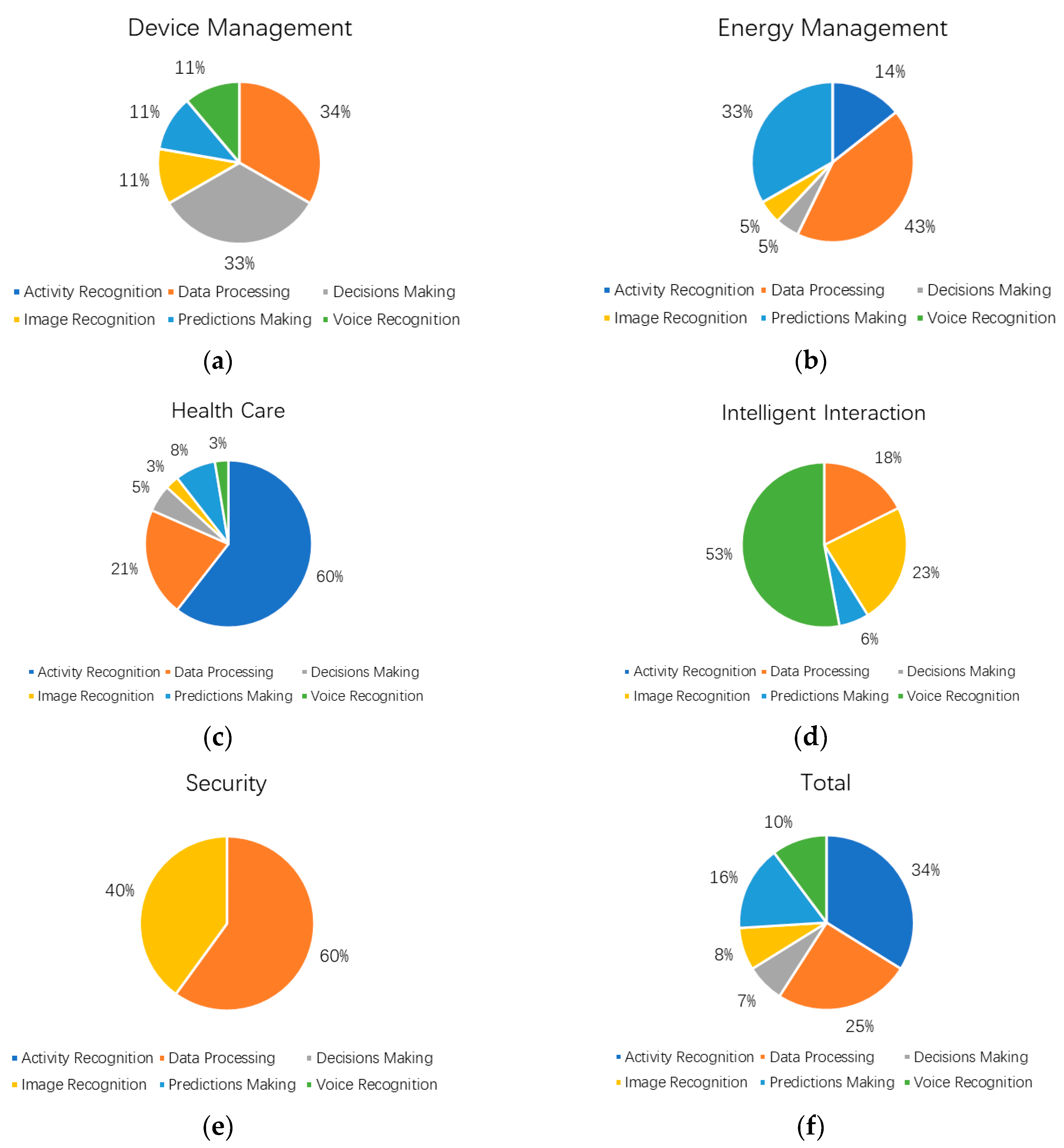
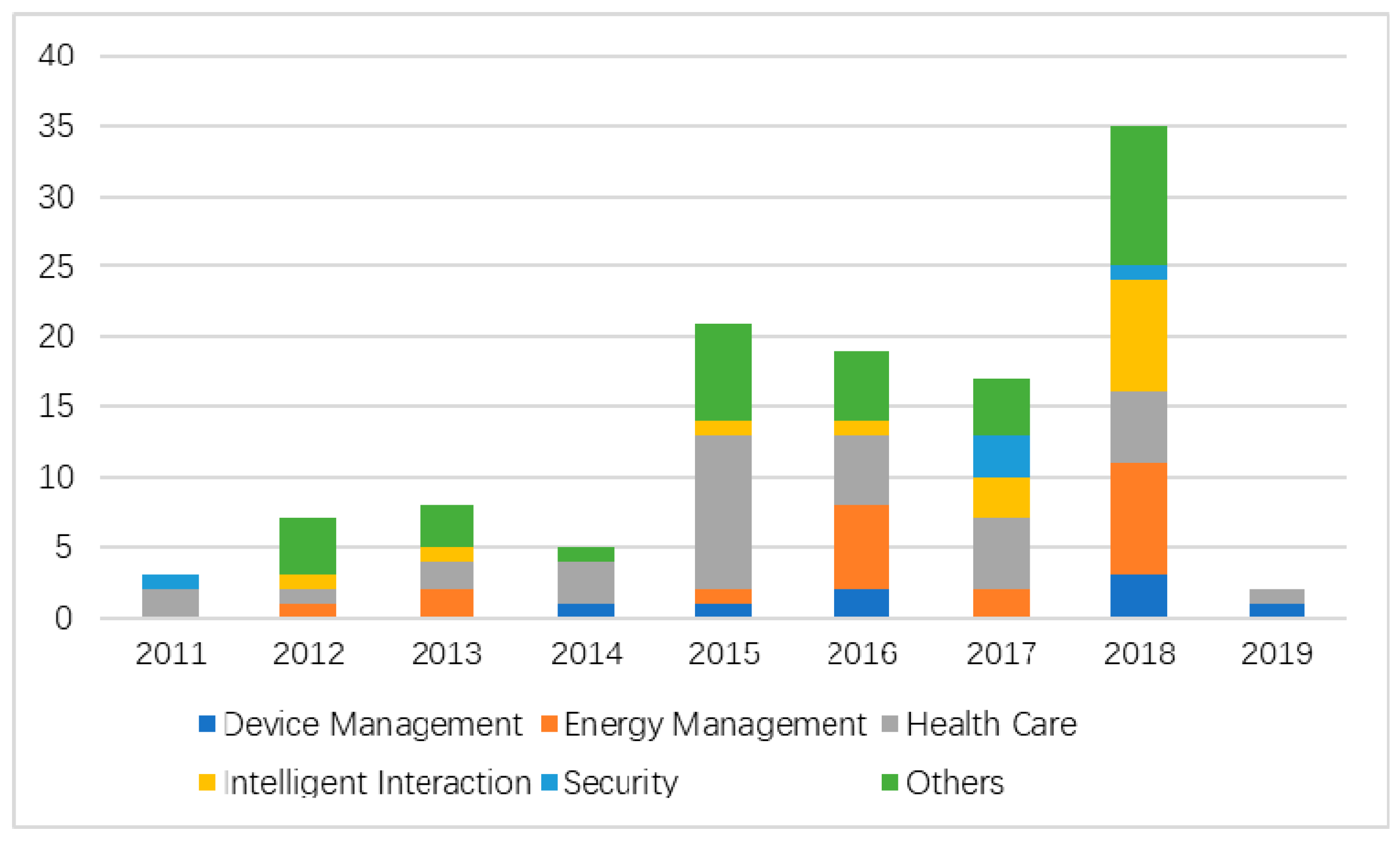
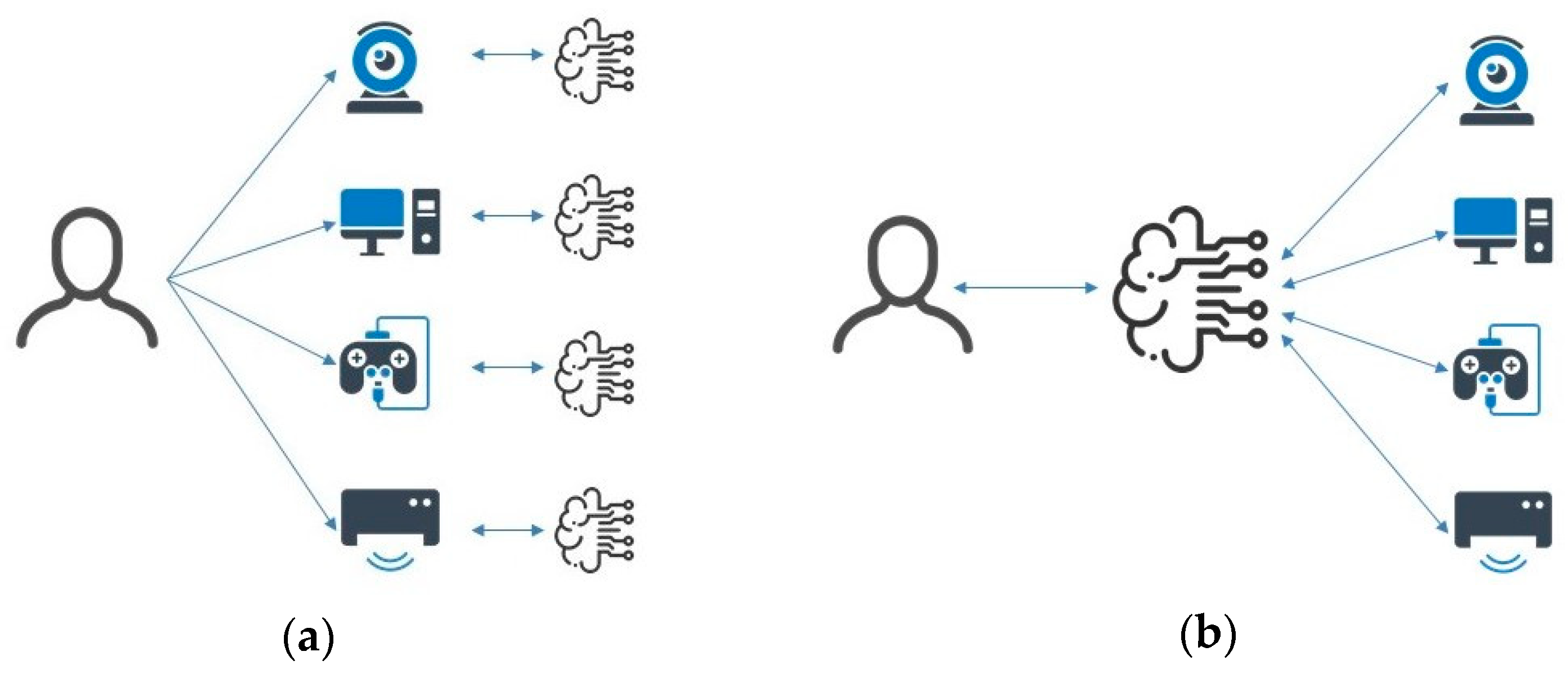
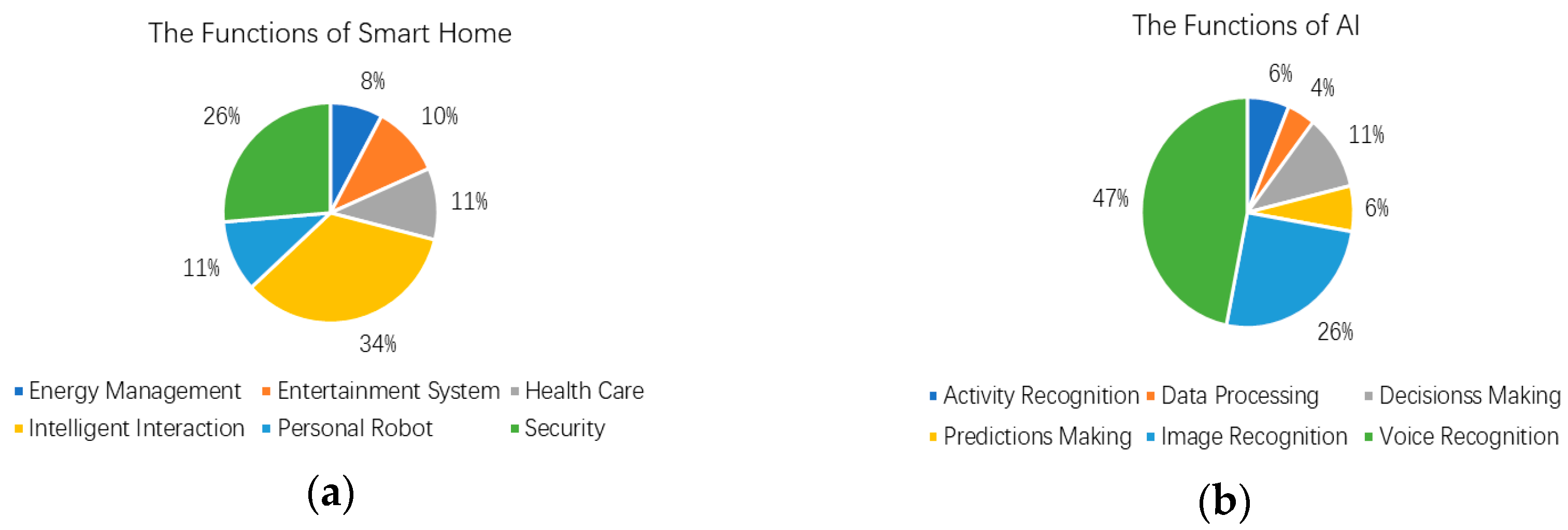
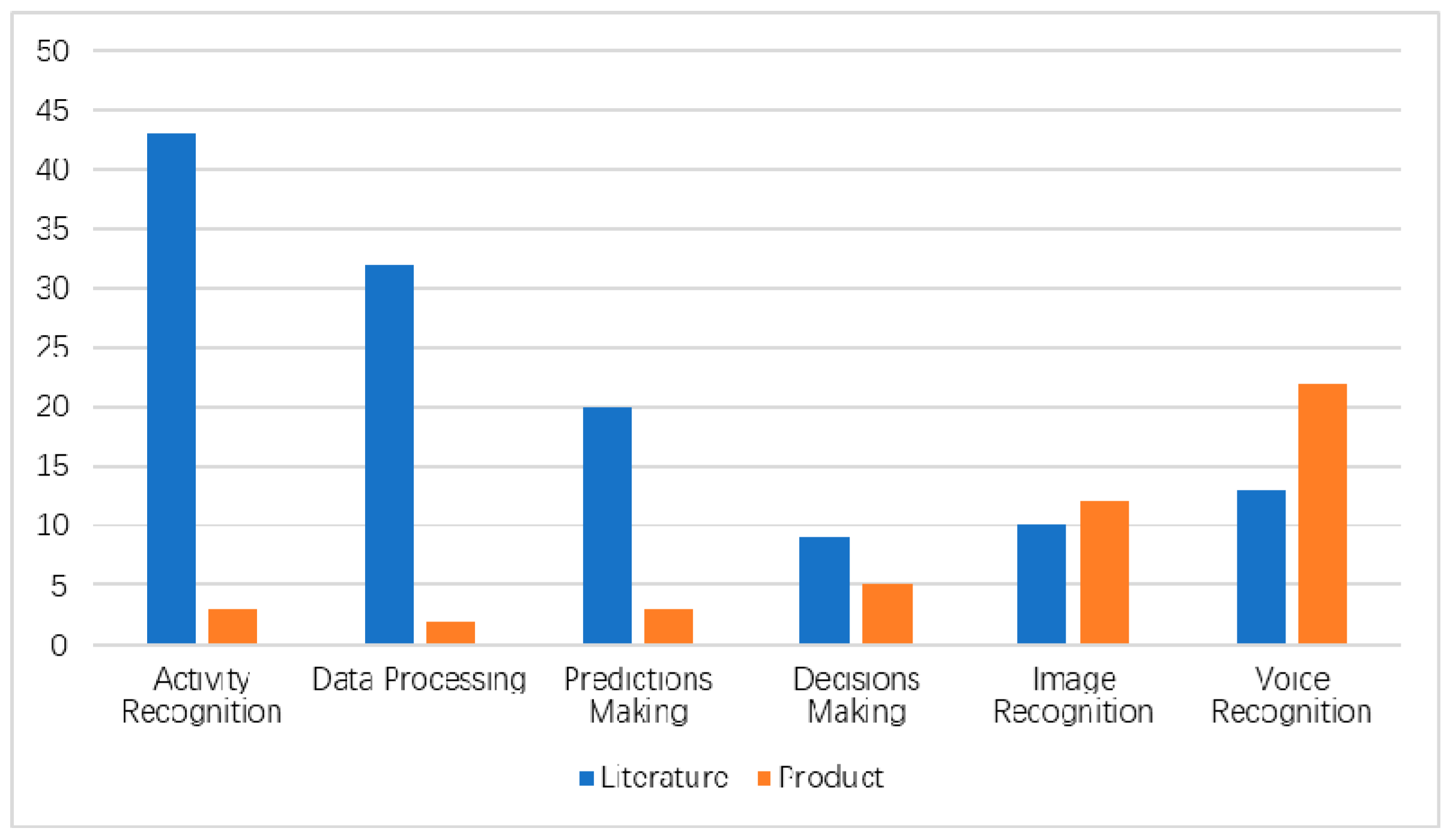
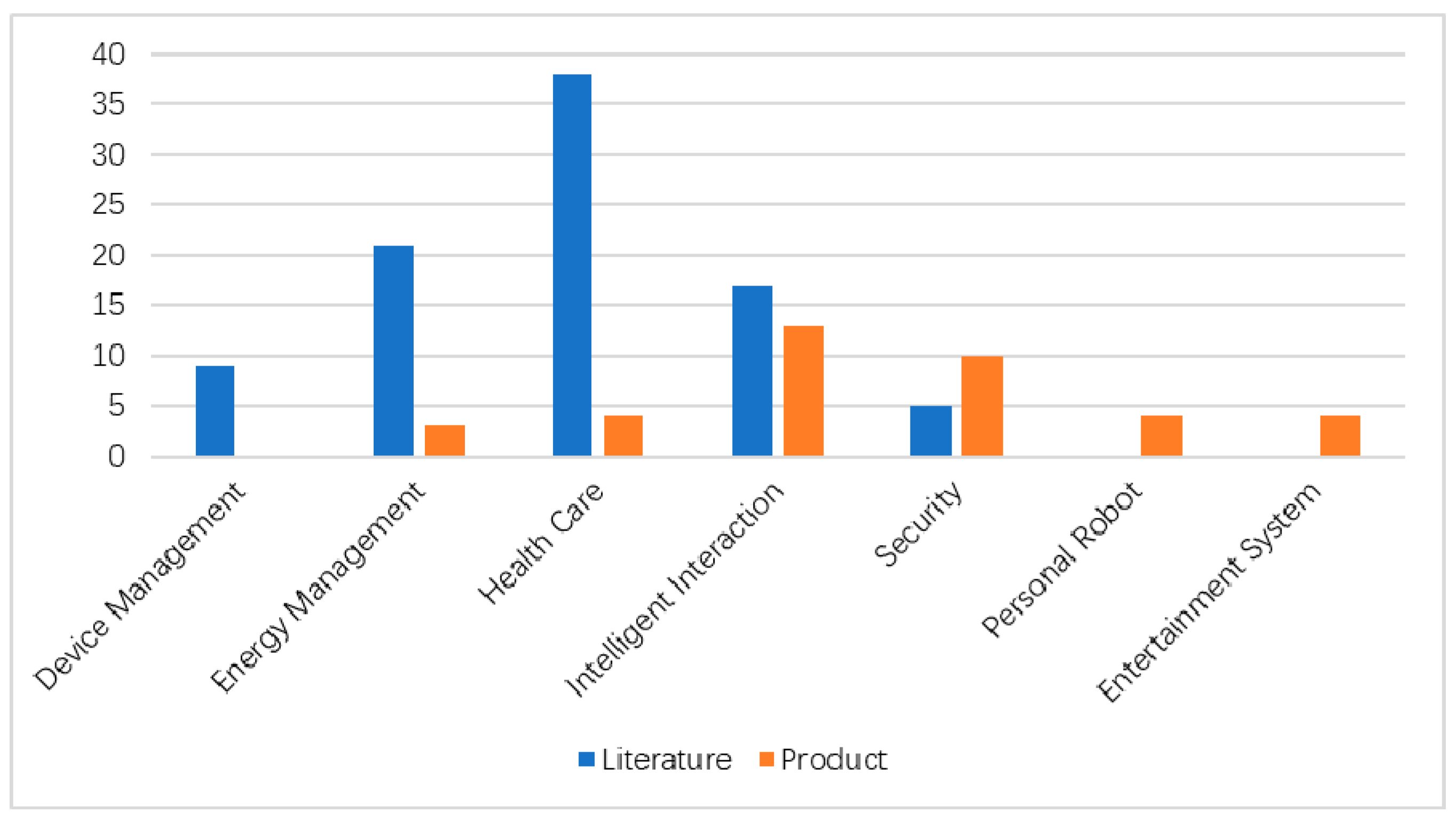
| Function | Cluster | Title | Year | Discipline |
|---|---|---|---|---|
| Device Management | Data Processing | Design of TensorFlow-based proactive smart home managers | 2018 | Engineering |
| Device Management | Data Processing | Created in close interaction with the industry: the smart appliances reference (SAREF) ontology | 2015 | Computer Science |
| Device Management | Data Processing | A semantics-rich information technology architecture for smart buildings | 2014 | Engineering |
| Device Management | Decision-Making | Rudas: energy and sensor device management system in home automation | 2016 | Other |
| Device Management | Voice Recognition; Decision-Making | A voice-controlled smart home solution with a centralized management framework implemented using AI and NLP | 2018 | Computer Science |
| … | … | … | … | … |
| Energy Management | Activity Recognition | User activity recognition for energy saving in smart home environment | 2016 | Computer Science |
| Energy Management | Activity Recognition | Unsupervised detection of unusual behaviors from smart home energy data | 2016 | Computer Science |
| Energy Management | Activity Recognition | A user behavior-driven smart-home gateway for energy management | 2016 | Computer Science |
| … | … | … | … | … |
| Healthcare | Activity Recognition | Activity recognition system for dementia in smart homes based on wearable sensor data | 2019 | Computer Science |
| Healthcare | Activity Recognition | A novel and distributed approach for activity recognition inside smart homes | 2018 | Computer Science |
| Healthcare | Activity Recognition | A novel method for detecting and predicting resident’s behavior in smart homes | 2018 | Computer Science |
| … | … | … | … | … |
| Intelligent Interaction | Data Processing | Design and implementation of a smart home system using multisensor data fusion technology | 2017 | Engineering |
| Intelligent Interaction | Data Processing | User needs and wishes in smart homes: What can artificial intelligence contribute | 2017 | Other |
| Intelligent Interaction | Data Processing | An interaction-centric dataset for learning automation rules in smart homes | 2016 | Other |
| … | … | … | … | … |
| Security | Data Processing | Distributed and in situ machine learning for smart-homes and buildings: Application to alarm sound detection | 2017 | Other |
| Security | Data Processing | Detecting anomalous sensor events in smart home data for enhancing the living experience | 2011 | Computer Science |
| Security | Data Processing | Design and implementation of a smart home system using multisensor data fusion technology | 2017 | Engineering |
| … | … | … | … | … |
| Other | Prediction-Making | Hardware simulation of pattern matching and reinforcement learning to predict the user next action of smart home device usage | 2013 | Computer Science |
| Other | Voice Recognition | Making context-aware decision from uncertain information in a smart home: A Markov logic network approach | 2013 | Computer Science |
| Other | Voice Recognition | Semantic validation of uttered commands in voice-activated home automation | 2012 | Computer Science |
| Function | Technology | Product | Year |
|---|---|---|---|
| Energy Management | Decision-making; Prediction-making | Nest Learning Thermostat (3rd Generation) | 2015 |
| Energy Management | Decision-making | Ecobee4 | 2017 |
| Energy Management | Decision-making | VELUX roof windows / blinds | 2017 |
| … | … | … | … |
| Healthcare | Activity Recognition; Decision-Making | Walabot HOME | 2018 |
| Healthcare | Activity Recognition | Hive Link | 2019 |
| Healthcare | Activity Recognition; Voice Recognition | Essence Care@Home | 2016 |
| Healthcare | Voice Recognition; Image Recognition | Pillo Health | 2016 |
| Intelligent Interaction | Prediction-making | Viaroom home | 2018 |
| Intelligent Interaction | Voice Recognition | Echo Dot (2nd Generation)—Alexa-Enabled | 2016 |
| Intelligent Interaction | Voice Recognition | Amazon Echo—Alexa-Enabled | 2014 |
| … | … | … | … |
| Personal Robot | Voice Recognition; Image Recognition | MATRIX | 2015 |
| Personal Robot | Voice Recognition; Image Recognition | Jibo | 2015 |
| Personal Robot | Voice Recognition; Image Recognition | ElliQ | 2019 |
| Personal Robot | Voice Recognition; Image Recognition; Prediction-making | Olly | 2017 |
| … | … | … | … |
| Security | Image Recognition | Honeywell Smart Home Security System | 2017 |
| Security | Image Recognition | Tend Secure Lynx Indoor Camera | 2017 |
| Security | Image Recognition | Canary All-In-One | 2016 |
| Security | Image Recognition | Netatmo Welcome Indoor Security Camera | 2015 |
© 2019 by the authors. Licensee MDPI, Basel, Switzerland. This article is an open access article distributed under the terms and conditions of the Creative Commons Attribution (CC BY) license (http://creativecommons.org/licenses/by/4.0/).
Share and Cite
Guo, X.; Shen, Z.; Zhang, Y.; Wu, T. Review on the Application of Artificial Intelligence in Smart Homes. Smart Cities 2019, 2, 402-420. https://doi.org/10.3390/smartcities2030025
Guo X, Shen Z, Zhang Y, Wu T. Review on the Application of Artificial Intelligence in Smart Homes. Smart Cities. 2019; 2(3):402-420. https://doi.org/10.3390/smartcities2030025
Chicago/Turabian StyleGuo, Xiao, Zhenjiang Shen, Yajing Zhang, and Teng Wu. 2019. "Review on the Application of Artificial Intelligence in Smart Homes" Smart Cities 2, no. 3: 402-420. https://doi.org/10.3390/smartcities2030025
APA StyleGuo, X., Shen, Z., Zhang, Y., & Wu, T. (2019). Review on the Application of Artificial Intelligence in Smart Homes. Smart Cities, 2(3), 402-420. https://doi.org/10.3390/smartcities2030025






